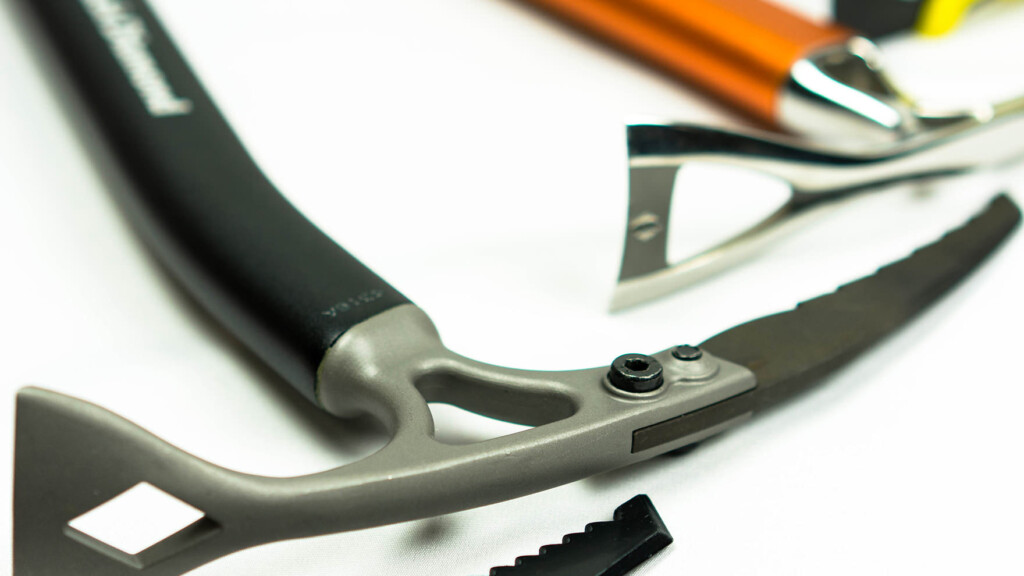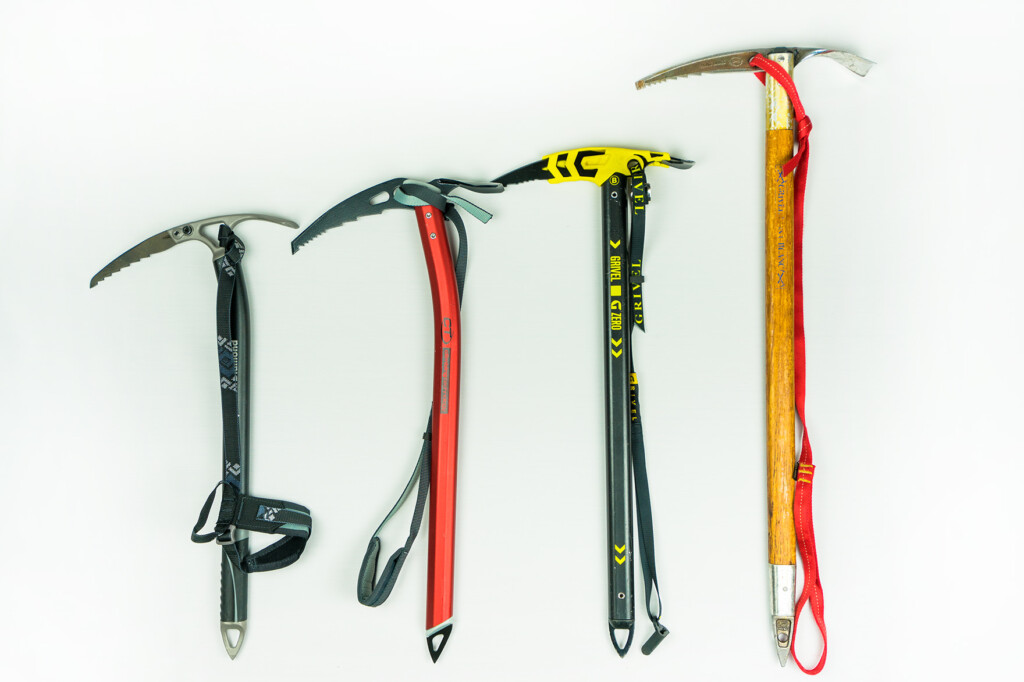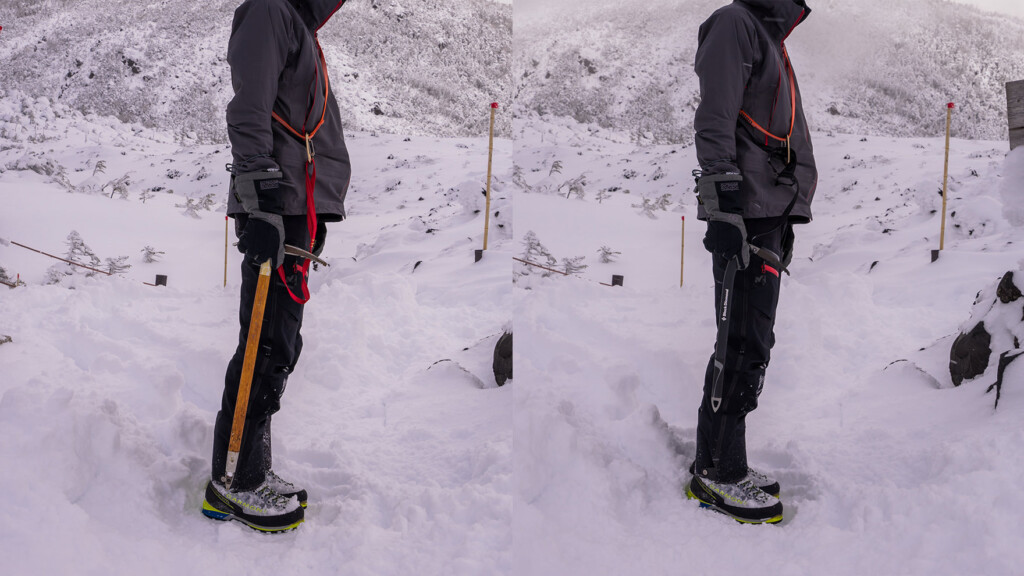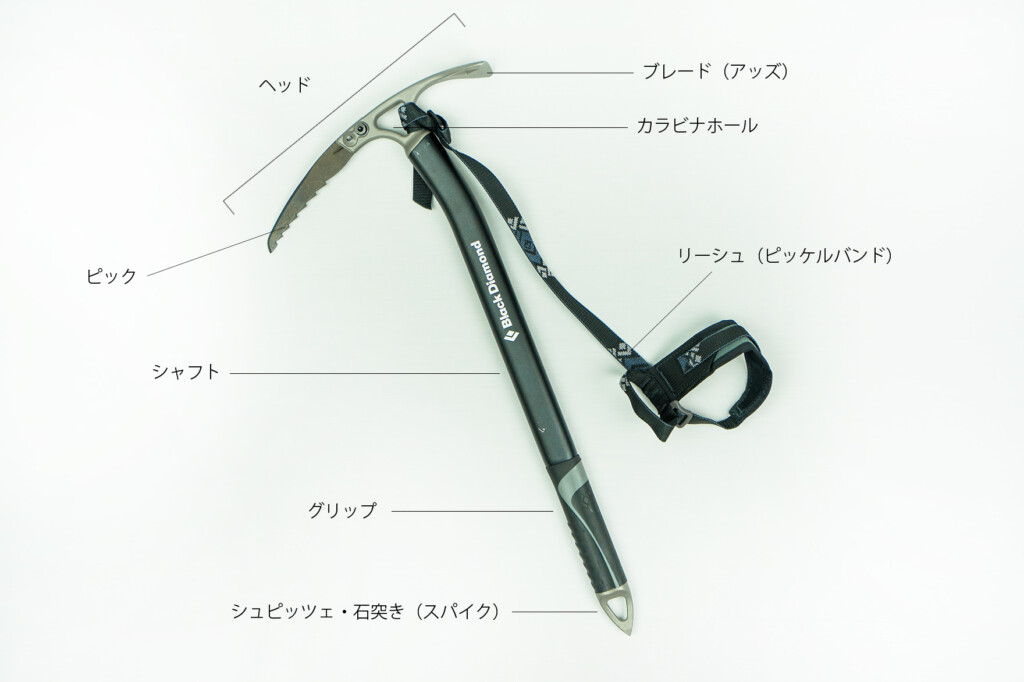
Let's think again about choosing the perfect pickel (ice axe) for snowy mountain walking
table of contents
- Whether you have any kind of affection or not, it is an indispensable symbol of a mountain climber on snowy mountains.
- When summarizing the selection method
- table of contents
- What does a pickel do? ~Names of each part and the 10 roles~
- Point 1: Classification by shape - Do not stretch your body
- Point 2: Length - Choose from height and activity
Whether you have any kind of affection or not, it is an indispensable symbol of a mountain climber on snowy mountains.
I first picked up a pickel over 20 years ago. It was a 70cm long wooden model lying in the club room, probably left behind by alumni. Although wooden shafts were already becoming obsolete in terms of functionality at the time, what attracted me to them wasn't about their functionality, but more than anything, the vintage texture created by the wood shaft, which was soaked in plenty of flaxseed oil, was irresistibly attractive, and just wearing it inspired me to climb. That kind of feeling remains unchanged, and no matter how many newer models I buy, I still can't let go of this pickle.
I am not the only one who has been fascinated by such a dignified and elegant appearance. Among the many mountaineering equipment, the pickel has been loved by many mountaineers, both in the East and West, as a symbol of the culture of mountaineering, especially in the culture of mountaineering.
In the past, each piece was handmade by a blacksmith, so it was also said to be the "spirit of a mountaineer" just like a Japanese sword. By the way, the word pickel is German (Eispickel), in English it is Ice Axe, in French it is Piolet, and in Italian it is Piccozza. Italian seems weak.
It is said that it originally began in the mid-19th century with the idea of a local mountain guide, which combines the "stock" (stands) to maintain balance and the "axes" to crush ice and snow, which were carried separately at the time when climbing the European Alps, where long glaciers lie (Hotta Koji, "Challenge to the Mountains - Talking Equipment," Iwanami Shinsho). Now that it has evolved and diversified over the course of over 100 years, it is naturally no special equipment that brings a soul to a single model, but it is no different from a normal mountain tool that allows you to choose from a variety of different types depending on your purpose and purpose.
Once you buy a pickle, it's hard to replace it, but after buying a new model this season, I thought I'd try to organize the best pickles again, so I've put together a summary of the latest information.
When summarizing the selection method
As I will explain later, pickles come in a variety of different types depending on your purpose, from general traversals to technical climbing, from specialized models to wide range of models, but for now, this article does not keep in mind so-called ice climbing, such as climbing ice walls. The use scenes are from general snowy mountain climbing to variations such as snow ridges where climbing steep slopes that are necessary to be secured.
In addition, climbing techniques and climbing equipment evolve every day, affecting each other. Even though they have their own experience, it is only quite limited. The reality is that even professionals have a variety of different claims and opinions regarding pickels, which are gears that are required to be used in fairly severe situations. So this time, we have been more careful and compiling past guide articles as deeply as possible, and then a three-dimensional investigation into them.
What's more, it's better to have more up-to-date and specialized information. So this time, I've also participated in the gear courses offered for free at XXXXX and XXX Sports, and decided to relearn a wider learning experience, including the latest circumstances. As an aside, this gear course is more recommended than expected, as it is free, with active guides and athletes talking to you as instructors, and you can directly ask questions.
table of contents
- What does a pickel do? ~Names of each part and the 10 roles~
- Point 1: Classification by shape - Do not stretch your body
- Point 2: Length - Choose from height and activity
- Point 3: Weight and Strength - Choose according to your purpose - (Page: 2)
- Point 4: Ease of use - Don't take it lightly (Page: 2)
- Point 5: Others - Accessories you should prepare - (Page: 2)
- Summary (Page: 2)
What does a pickel do? ~Names of each part and the 10 roles~
What is a pickel gear for you to do? As basic knowledge, I will write down the main role of the pickel. First of all, as can be seen from the role of normal walking,
- Balance as a cane when walking
This is the most basic role of a pickel. However, with the widespread use of stock now, the need for a pickle to be inevitably weakened depending on the situation. on the other hand,
- Pick and Spizzeze on steep slopes to use support points
- The moment you trip, stick it on the slope to prevent it from falling
- When thrusts or gusts of wind, bend over with the pickel to take a windproof posture.
- Stop slipping to prevent falling when falling on a slope
As far as members go to the snowy mountains, these roles are probably the most important and critical roles, both now and in the past. The main reason for this is that all of these can only be done by a pickel and at the same time they are directly life-threatening. others,
- Bow in the snow to use the fulcrum
- Shaving hard slopes to create shelves to lower scaffolding and backpacks
- Use it as a peg for your tent (Note: Please be sure to avoid snow filling up and not being able to remove it)
- Crush hard ice that cannot be broken with a shovel (such as when leveling the ground at a campsite).
- Maintaining balance during glycides and silysides (techniques for quickly sliding down the road)
It is a good idea to know that by using it flexibly and efficiently, it will play a variety of effective roles.
Point 1: Classification by shape - Do not stretch your body
When you look at the catalog to choose a pickle, the first thing you'll find yourself thinking about is the shape. Recent traversal pickles can be roughly divided into three categories depending on their shape (table below).
Before that, I will repeat the premise, but even though it is called a curve, the model with a curved entirely like a banana is for technical (ice) climbing, where you can climb by placing your entire weight on a pick thrusts on an ice pillar or something, so if you're walking around the snowy mountain, you should forget for now (photo). With this in mind, it seems that, recently there have been many types for mountaineering and ultra-lightweight ski touring, with the only option for straights in the past, and many types for ski touring, with the root part (head side) of the shaft slightly curved.
As shown in the table above, the mountaineering type has the advantage of higher impact force (easiness to drive) on the snow when the pickle is swinged down, and when you grip the top of the shaft on a steep slope and stab the pick, and the two points of the pick and shaft make it easier to contact the ground, making it easier to support and more stable, which in other words, the advantages of increasing operability on steep slopes. Therefore, it is certain that the more technical routes such as steep slopes and rock-snow mixed strips, the more advantageous a curved shaft will be.
As someone who is about to choose one, I tend to be tempted by people with a lot of new products and some who are visually cool, but I'm a bit unsure how many people really need the mountaineering type.
The routes that are seen in many guidebooks and records have been a part of our ancestors since ancient times using traditional straight shafts, and it is also true that models for general traverses are cheaper than anything else, and there are many elements that are convenient for beginners. There are some who say that it would be more comfortable to use stock and pickle depending on the slope, but I don't think it's actually realistic to say that people who have not yet experienced snowy mountains should use stock and pickle cleverly.
For example, if you think about taking someone to a snowy mountain for the first time, I would like you to use a pickel early to get accustomed to walking, so that you can get used to the way you walk. Also, the opportunity to take difficult routes doesn't come very quickly, so by then you'll likely be able to see a route that really suits you. Considering this from various perspectives, unless you have a lot of confidence or preference, I think you'll first recommend an affordable straight shaft.
Tips for choosing
- First, consider whether to use it in conjunction with stock . When using this product in conjunction with the product, it is assumed that you will be physically stamina with more luggage, that the entire party can accurately determine whether it is a stock or a pickle, and that you will need to have enough experience to switch over without being too busy even in difficult situations.
- If you are not using it in conjunction with stock a straight shaft for traversing (a slightly longer length) that is cheap, lightweight, gentle slope, easy to use, and simple to use, with a straight shaft that is suitable for traversing (a little longer length) for use.
- If you are using it in conjunction with stock it can be considered that you leave it to the stock up to the gentle slopes, so we recommend mountaineering (short length) which is advantageous on steep slopes, and ski touring (lightweight type) if it is possible to say that there are almost no dangerous places that you can't climb unless you stick a pick .
Point 2: Length - Choose from height and activity

Difference in length. From left: Black Diamond Venomouss (50cm), Climbing Technology Alpine Tour (55cm), Grivel G Zero (58cm), Grivel Model unknown (70cm)
Why did the optimum length of the pickle get shorter?
Pickel lengths are mostly available in multiple lengths among the same model, and today there are variations in widths of approximately 50 to 75 cm. What is the general perception of the current optimal length? According to the 2015 Bessatsu PEAKS Latest Snow Mountain Gear Guide, it is generally around 60cm, and 55-70cm is easier to use depending on your height. A little while ago, best -selling size from 2009 was 55-65cm.
This is not indeed a mistake, but it's a bit frustrating.
In the 1970s, there were even mentions that mountaineering equipment guides require something around 70 to 85 cm, and from today's perspective, a model of the old pickel model was recommended (Takahashi Kazuyuki, Research on Mountaineering Equipment, Uni Publishing). Why are the best length recommendations so short when the mountains and people remain the same? So I thought about it a little lazily. If you don't have time, you can skip it.
There certainly seem to be several reasons why the optimum length has changed in this way. The first thing that comes to mind is that the evolution of climbing techniques has led to the popularity of short pickles. " The Encyclopedia of Mountain Equipment " and other literature, with the spread of the climbing technology "Pioletraction or Double Axe (a method of driving a pick into an ice wall with a short shaft)," developed in the early 1970s, models suitable for this technology were introduced one after another. At the time, the size suitable for piole traction was considered to be around 50 to 65 cm (Takahashi Kazuyuki, Research on Mountain Climbing Equipment, Uni Publishing).
Another reason is that the combination of stocks has progressed. It has long been common for deep Russells to say that stockings are more advantageous than pickles (Takahashi Kazuyuki, Research on Mountain Climbing Equipment, Uni Publishing), but the April 1990 issue of Mountains and Valleys stated, "As a traverse is suitable for traverses, it is appropriate to 55 to 75 cm based on height," and also mentioned the advantages of stockings as canes in the form of adjustable ski stocks that do not have as much functionality as pickles, but are effective as versatile canes."
From these statements, it is fairly easy to guess that over time, the role trend required for a pickel has shifted from a "wand to maintain balance" to "swaying the shaft and driving it in and using it as a fulcrum." As users sought these trends, manufacturers began to create shorter models. The media also began to disseminate information that suited the situation, and before long it became common sense. I might have been overthinking it.
So, what I wanted to say is that if the recommended optimal length has become shorter for the above reasons, then wouldn't the optimum length be the same as before for traversing the general snowy mountains? That's what it means.
How is it best to measure your optimum length?
So, finally, it's time to get to the main topic. How to choose the optimum length? Here we will introduce how to think about mischief, taking into account various knowledge. In short, this is a simple way to choose based on your height x activity (the main terrain of the route) so that you won't be left unnecessarily confused by current trends. However, I think the way people feel that it is easy to use varies slightly, so please refer to the following parts that make sense, and ultimately try to find a size that suits you by experience.
First, measure the standard size, which will be the basis for your optimal size, based on your height. If you summarise multiple opinions, such as guide books and lecturers, there are several ways to do this. for example
- The length is about 110cm less than the height.
- When you hold the head upright, the tip of the pickle is long enough to lie around your ankle.
- When you grip the head and hold it horizontally and point the Spitze along your arms towards the torso, it is just long enough to pass through your armpits.
By the way, when I tried it on my height, everything was almost 65cm long, so I think it doesn't make much difference no matter how you measure it. For now, let's use this as the standard size for your own optimal length.
From here, we will consider your optimum length according to each activity. Specifically, the optimum length will be divided according to the main terrain of the route we are heading for, or how technically difficult the most difficult terrain at the core is, as follows:
[Reference] The length that the author (standard size 65cm) felt was just right
Of course, some people think that if you choose a length of about 60 to 65cm, you can use it all in one. However, there is a risk that it will become half-hearted no matter what you use it for, so from personal experience it is recommended to determine the purpose and use it in a way that is well-defined.
| kinds | Slow slope (for traversing) | It's on a steep slope, but you can walk with a pickle (for variation routes) | Climbing is required (for even more difficult routes) |
|---|---|---|---|
| Advantageous length | A longer one that's easier to thrust Spitze into the ground is better. | The shorter shaft is easier to secure and the easier it can handle. | The shorter one is ◯ because the pickle is driven |
| Optimal length (in the case of the author) | Standard size +5cm (65-70cm) | Standard size - 10cm (50~55cm) | Fixed (50cm) |

A comparison of the heights of pickle sizes. It's just around the ankle with a 70cm pickle (left). A 50cm pickel (right) cannot be considered a cane unless it is a fairly steep slope.
Tips for choosing:
- There is no pickle length that can be covered in just one piece. it is recommended to choose between different pickles
- If the route has fewer steep slopes, a longer size is easier to use, and if the route has many steep slopes or more severe, a shorter size is easier to use.
- If you choose a shorter size, stocking is effective for maintaining balance on gentle slopes .







